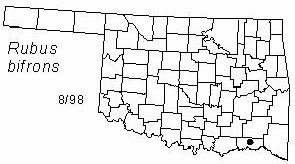Arching, upright shrub to 3 m (9 ft) in height. Twigs angled to terete, scantly pilose to pubescent; prickles scattered and variable in length, 4-8 mm (1/6-1/3 in), straight to nearly hooked. Leaves alternate, palmately compound, 5-foliate; leaflets ovate-elliptic, 7.5-8.5 cm (3-3.5 in) long and 5-6 cm (2-2.5 in) broad; glabrous above, brown-canescent to tomentose beneath; narrowed at the base; gradually or abruptly narrowed at apex; margins finely or acutely serrate; armed with short hooked spines; petioles and rachis are also armed with short hooked spines. Inflorescence a terminal raceme with multiple flowers, peduncles and pedicels tomentose with straight spines; flowers 2-5 cm (0.8-2 in) in diameter; calyx 5-lobed, becoming reflexed; petals 5, white to rose colored; styles many, inserted on hypanthium; stamens numerous; flowers appear from May to June. Fruit an aggregation of drupelets, about 15 mm (0.6 in) in diameter, black; fruits mature June to July.
Distribution: A widely planted native of Europe. Escapes from cultivation.
Habitat: gardens, fence rows and old-fields.
Comment: Rubus is a Roman name meaning red; bifrons refers to the dimorphic leaves.
Field identification: this blackberry is glandless. Rubus is a complex genus. Species are difficult to identify due to frequent hybridization and introgression.
Food uses: fruits can be eaten raw or used in jams, jellies, and sauces.
Wildlife benefits: blackberry fruits are eaten by many species of birds and mammals.
NWI status: none
Distribution in Oklahoma: 
BACK
NEXT
RETURN TO INDEX
Last update: 9/17/99
 Go to Oklahoma Biological Survey Home Page
Go to Oklahoma Biological Survey Home Page
 Disclaimer
Disclaimer